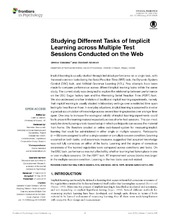| dc.contributor.author | Sævland, Werner | |
| dc.contributor.author | Norman, Elisabeth | |
| dc.date.accessioned | 2016-06-29T08:43:43Z | |
| dc.date.available | 2016-06-29T08:43:43Z | |
| dc.date.issued | 2016-06-07 | |
| dc.identifier.issn | 1664-1078 | |
| dc.identifier.uri | https://hdl.handle.net/1956/12210 | |
| dc.description.abstract | Implicit learning is usually studied through individual performance on a single task, with the most common tasks being the Serial Reaction Time (SRT) task, the Dynamic System Control (DSC) task, and Artificial Grammar Learning (AGL). Few attempts have been made to compare performance across different implicit learning tasks within the same study. The current study was designed to explore the relationship between performance on the DSC Sugar factory task and the Alternating Serial Reaction Time (ASRT) task. We also addressed another limitation of traditional implicit learning experiments, namely that implicit learning is usually studied in laboratory settings over a restricted time span lasting for less than an hour. In everyday situations, implicit learning is assumed to involve a gradual accumulation of knowledge across several learning episodes over a longer time span. One way to increase the ecological validity of implicit learning experiments could be to present the learning material repeatedly across shorter test sessions. This can most easily be done by using a web-based setup in which participants can access the material from home. We therefore created an online web-based system for measuring implicit learning that could be administered in either single or multiple sessions. Participants (n = 66) were assigned to either a single session or a multiple session condition. Learning occurred on both tasks, and awareness measures suggested that acquired knowledge was not fully conscious on either of the tasks. Learning and the degree of conscious awareness of the learned regularities were compared across conditions and tasks. On the DSC task, performance was not affected by whether learning had taken place in one or over multiple sessions. On the ASRT task, RT improvement across blocks was larger in the multiple-session condition. Learning in the two tasks was not related. | en_US |
| dc.description.sponsorship | The project was supported by the Research Council of Norway (grant no. 163218; Framework Agreement for Student Research) and Skipsreder Jacob R. Olsen og hustru Johanne Georgine Olsens legat (grant no. 2015/9/FOL/BEKR). | eng |
| dc.language.iso | eng | eng |
| dc.publisher | Frontiers | eng |
| dc.rights | Attribution CC BY | eng |
| dc.rights.uri | https://creativecommons.org/licenses/by/4.0/ | eng |
| dc.subject | implicit learning | eng |
| dc.subject | multiple sessions | eng |
| dc.subject | time | eng |
| dc.subject | web-based | eng |
| dc.subject | online | eng |
| dc.subject | ASRT | eng |
| dc.subject | dynamic system control | eng |
| dc.subject | DSC | eng |
| dc.title | Studying Different Tasks of Implicit Learning across Multiple Test Sessions Conducted on the Web | eng |
| dc.type | Peer reviewed | |
| dc.type | Journal article | |
| dc.description.version | publishedVersion | |
| dc.rights.holder | Copyright © 2016 Sævland and Norman | eng |
| dc.source.articlenumber | 808 | |
| dc.identifier.doi | https://doi.org/10.3389/fpsyg.2016.00808 | |
| dc.identifier.cristin | 1362110 | |
| dc.source.journal | Frontiers in Psychology | |
| dc.source.40 | 7 | |
| dc.subject.nsi | VDP::Samfunnsvitenskap: 200 | |

